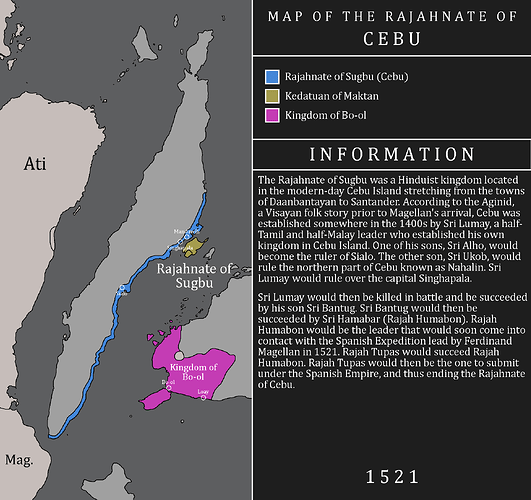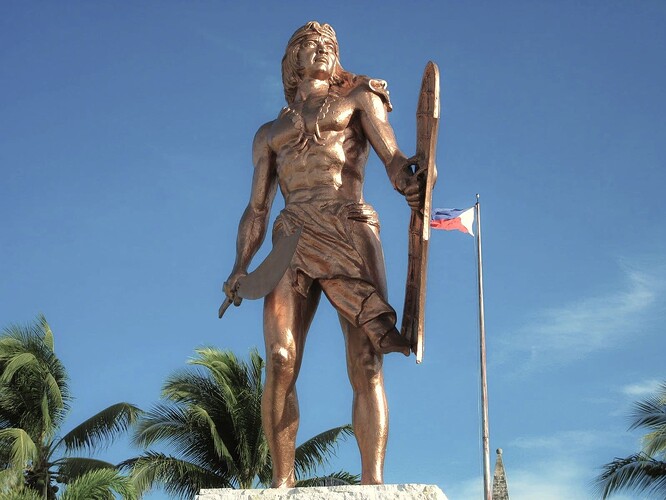It could be single civ dlc like AoE 3 that comes with Polynesians or a dlc that comes with Polynesians (with a Momo campaign in the 13th century) and Visayans (with a Lapulapu campaign between 1518 and 1521 ending in the battle of Mactan against Magellan)
- ʻAhoʻeitu – divine father, around 900 AD, resided first in Popua and then other places of the Hahake district, like Toloa near Fuaʻamotu.
- Lolofakangalo
- Fangaʻoneʻone
- Līhau
- Kofutu
- Kaloa
- Maʻuhau – residence in Lavengatonga
- ʻApuanea
- ʻAfulunga
- Momo – married with Nua, the daughter of Loʻau, the Tuʻi Haʻamea. The Tongan maritime empire came into existence. Royal court in Heketā near Niutōua.
- Tuʻitātui – around 1100 AD, extended the royal court, built the Haʻamonga; re-established the Fale Fā (house of four), royal counselors and guardians; his cunning stepbrother Fasiʻapule became a governor.
- Talatama – shifted the residence to Lapaha; died without issue
- Tuʻitonganui ko e Tamatou – said to have been a block of wood, standing in as child of Talatama and father of Talaihaʻapepe to keep the dynasty pure
- Talaihaʻapepe – real brother of Talatama and supposed grandson through the woodblock
- Talakaifaiki – around 1250; start of the decline of the Tongan maritime empire, lost Samoa due to his cruelty to the Mālietoa line
- ################### 17. Tuʻitonga Maʻakitoe
- Tuʻitonga Puipui
- Havea I – assassinated by a Fijian
- Tatafuʻeikimeimuʻa
- Lomiʻaetupuʻa
- Havea II – assassinated with an arrow by Tuluvota, a Fijian
- Takalaua – assassinated by Tamasia and Malofafa from ʻUvea and Futuna while taking his bath in the Tolopona stream at Alakifonua; a harsh ruler, start of political upheavals
- Kauʻulufonua I – around 1470, pursued his father’s murderers from Tongatapu to ʻEua, Haʻapai, Vavaʻu, both Niuas, then Niue, Fiji, Samoa, finally arresting them at their home island of either ʻUvea or Futuna. Back at home in Muʻa he killed them in a savage spectacle (knocking out their teeth and then letting them chew kava), before he devoured them giving him the nickname fekai. He allowed his younger brother Moʻungāmotuʻ to found a new dynasty, the Tuʻi Haʻatakalaua, named after their father. This new dynasty would carry out the day-to-day duties of the Tuʻi Tonga with the people while the Tuʻi Tonga became sacred, king of kings like a god.
- ######## – kept away from Tonga by the Tuʻi Haʻatakalaua, lived in Samoa.
- Puipuifatu – lived in Samoa, tried in vain to invade Vavaʻu to restore power to his dynasty
- Kauʻulufonua II – lived in Samoa
- Tapuʻosi – was allowed to return to Muʻa, as apparently the Tuʻi Tonga line was now so weakened as to be of no threat to the Tuʻi Haʻatakalaua. From now on the Tuʻi Tonga functioned as a kind of high priest, taking care of all religious obligations (an honour and a burden), giving him a very elevated status, but no worldly power. But no Tuʻi Tonga was ever murdered anymore either.
- ʻUluakimata I – also known as Teleʻa, builder of the greatest langi on Tongatapu
- Fatafehi – around 1600, married the Tuʻi Haʻatakalaua Moʻunga ʻo Tonga’s daughter, a custom which would last for some generations to come forming a permanent alliance between the two houses; his sister married a Fijian, changing the international orientation of Tonga from Samoa to Fiji. Was tattooed in Samoa by master tattooists in two sessions and received the nickname ############## (“Twice to Manuʻa”) in commemoration of these rituals.
- Kauʻulufonua III – was met by Abel Tasman in 1643



